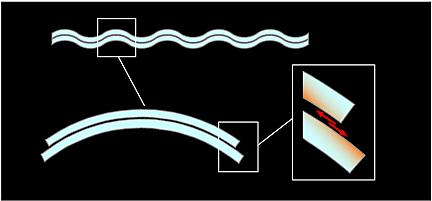Qboard
Report January 1995, ©Mats Andersen, Qln Acoustics AB
General
Qln strive in the direction of creating loudspeakers that reproduces the recorded signal without changes. Whether sound components are added or omitted, amplified, muted or distorted, it is still deviations from the original that distort the music.
The ideal speaker cabinet
Beside the characteristics of the driver units, the most important factor is the behaviour of the loudspeaker cabinet. The loudspeaker cabinet should ideally give a total absorption of the sound inside the cabinet. No acoustic energy should be
conveyed by the cabinet walls or reflected to the backside of the diaphragm of the driver. At the same time it should provide conditions for the driver to operate under controlled and favourable conditions. In real life things are, as we know, a little
different.
Structural vibrations main source of distortion
Radiation of structural vibrations is the prime cause of disturbing tones and distortion from a loudspeaker cabinet. To reduce these vibrations you can increase the mass and rigidity of the cabinet walls, it takes more energy to excite more mass.
But even more important to the audible result is how soon the vibrations cease. This is set by the internal damping of the cabinet material, a measure of the ability of a material to transform oscillatory energy (vibrations) into heat. The higher the internal damping, the more sound energy is absorbed within a given time, and less resonant the loudspeaker will be.
Most loudspeaker cabinets are single-walled and made out of chipboard, hardboard or solid wood, to an overall thickness of 12-22 mm. Such materials are not ideally suited for cabinets because they are relatively low in weight, rigidity and have poor internal damping.
Q-board- taking care of the real problem
Qboard combines the two principal methods; high density to reduce amplitude of the vibrations as such, and very high internal damping to minimise the effects of the vibrations remaining. The damping characteristics of a material are expressed by the
unity loss factor. The higher the loss factor the higher the internal damping.
The loss factor for wood or concrete is only 0.01 – 0.02 but for lead 0.08 (hit these materials with a hammer and you will notice the difference in damping characteristics). The loss factor for Qboard is 0.48, giving a nearly ideal blend of rigidity, mass, and internal vibration damping.

 How it works
How it works
Q-board consists of two layers of high density material bound together by a viscoelastic layer. The high-density board provides mass, and the viscoelastic layer gives internal damping. The energy is transferred into the cabinet structure in two ways, and it all works like this:
Deformation
Bending of a multi-layer construction such as Q-board means that the damping layer is mainly exposed to shear strains, and that the biggest part of the energy in the bending wave is transmitted into heat through internal friction in the viscoelastic
layer.

 The vibrations are damped and the noise is reduced. So, by building the loudspeaker heavy and rigid we reduce the initial amount of structural vibrations, and by Q-board the remaining vibrations are absorbed much better than with any other material.
The vibrations are damped and the noise is reduced. So, by building the loudspeaker heavy and rigid we reduce the initial amount of structural vibrations, and by Q-board the remaining vibrations are absorbed much better than with any other material.
Mölndal, January 1995
Mats Andersen
